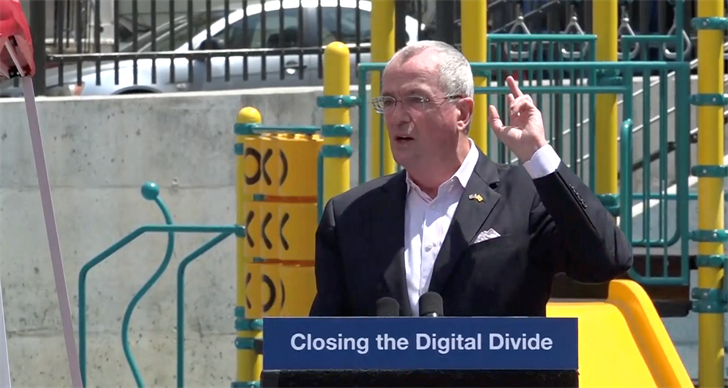This afternoon Gov. Phil Murphy held a press conference in Irvington to announce a plan to supply New Jersey K-12 students with access to one-on-one devices and broadband internet. This project comes after community and legislative outcries of unfairness because up to 240,000 students were affected by lack of access when schools closed in mid-March.
According to the press release from the Governor’s Office (see below) the NJ Economic Authority will issue today “a Request for Information (RFI), seeking information and ideas to bridge the digital divide for New Jersey’s pre-K-to-12 students, including philanthropic support from companies and organizations to help close the digital divide in public schools.” The NJ DOE will kick in $10 million in federal CARES Act money and, if necessary, the State will add up to $44 million in Coronavirus Relief Fund (CRF) funds, plus another $6 million for private schools.. Then school districts can apply for the money.
For more NJLB coverage of the DOE’s failure to bridge the digital divide in NJ schools during the pandemic, see here, here, here, here, here, and here.
Three-Pronged Approach Aims to Close Existing Gaps in Student Access to Devices and Internet Connectivity
IRVINGTON – Governor Phil Murphy today unveiled his Administration’s plan to address unmet pre-K-to-12 student technological needs in New Jersey schools, commonly referred to as “the digital divide.” Efforts to ensure reliable internet connectivity and access to one-to-one digital devices are critical as we look ahead to the 2020-2021 school year and the reopening of schools, many of which are preparing reopening plans employing a hybrid schedule of both in-person and continued remote learning due to the ongoing COVID-19 pandemic.
“One thing the 2019-2020 school year taught us is just how resilient and innovative our students and educators can be, particularly in times of crisis,” said Governor Murphy. “By taking these steps to close the digital divide and equip students in need with personal device access and internet connectivity, we can ensure that students continue to succeed in these unprecedented times.”
The Administration’s approach to closing the digital divide is three-pronged and consists of the following:
- The New Jersey Economic Development Authority (NJEDA) released today a Request for Information (RFI), seeking information and ideas to bridge the digital divide for New Jersey’s pre-K-to-12 students, including philanthropic support from companies and organizations to help close the digital divide in public schools. The RFI is available here and interested parties will have until July 31, 2020 to respond. District information from the New Jersey Department of Education (DOE) will help connect school districts in need with identified philanthropic partners and potential solutions.
- The DOE will offer a one-time $10 million formula grant using a portion of the State’s federal Coronavirus Aid, Relief, and Economic Security (CARES) Act Elementary and Secondary School Emergency Relief (ESSER) funds. This funding will be disbursed to public school districts to purchase digital devices and internet connectivity for one-to-one student use based on need and the availability of philanthropic donations. Districts will be required to submit an application to DOE, which will be released next week, and demonstrate a plan for appropriate use of funds.
- After philanthropy and ESSER Fund grants have been exhausted, the Administration will redirect Coronavirus Relief Fund (CRF) funds to close any remaining gap and fill the unmet digital device and internet connectivity needs of New Jersey students. Up to $44 million in CRF funds will be available for this purpose, with an additional $6 million available for nonpublic schools. Because of the ongoing and unparalleled financial strain the COVID-19 pandemic has created across the board in the State, is critical to exhaust philanthropic opportunities and CARES Act funding prior to filling remaining gaps with CRF funds. This will ensure that CRF funds can be efficiently directed to address as many critical needs as possible.
Schools in New Jersey were closed to in-person instruction in March 2020 when Governor Murphy signed Executive Order 104 to mitigate the spread of COVID-19. While school closures were necessary to protect public health, the DOE estimates that more than 230,000 students across the state have been impacted by the digital divide. Last month, the DOE released guidance to assist schools in preparing for the upcoming school year and establishing a learning model that includes the possibility of employing both remote and in-person learning, meaning that students will need continued access to the internet and digital devices. After considering other available district funding sources and estimating need based on June 2020 survey data and low-income enrollment data, the DOE estimates that the cost to close the digital divide is approximately $54 million.
“The digital divide leaves too many students in need at a severe disadvantage in gaining equal opportunities in education and much more needs to be done,” said Senate President Steve Sweeney. “Reading, writing and arithmetic are not enough without a laptop. The coronavirus and resulting school shutdowns have exposed how punishing this divide is for students who just can’t afford computers and other modern technologies that are considered a basic supply in most communities. Let’s take advantage of the lessons we are learning from this crisis to help close the divide and give our students the technological supplies they need.”
“This pandemic has brought into sharp focus the educational consequences of students going without adequate access to technology at home,” said Assembly Speaker Craig Coughlin. “While we cannot predict whether schools will again need to close, we must be better prepared. No student should be going without access to the tools and educational resources the vast majority of their peers have been able to enjoy. By bridging this digital divide, we can secure educational equity for students in New Jersey not only now, but in our future beyond this crisis.”
“There are thousands of kids around the state who, after three months of virtual instruction, still do not have access to the internet or a tablet, preventing them from connecting with their teachers or interacting with materials,” said Senator Teresa Ruiz, Chair of the Senate Education Committee. “This use of funding, to connect every single New Jersey student to online learning by the time school starts in the fall is critical to preventing further learning loss and ensuring we are prepared for what is to come in September and throughout the remainder of the school year. The pandemic has exacerbated and illuminated the divide in our educational settings and this is a meaningful first step towards bridging those gaps and achieving equity across our districts as we deal with this public health emergency and beyond.”
“Remote learning has been tough on every aspect of our educational system, especially our students of color,” said Senator Ron Rice. “Our urban students are falling behind other students around the state due to a lack of technology. We have not yet seen the second wave of COVID-19 in New Jersey and must be prepared for our students to be taught remotely again to start the school year. In order to prevent lower levels of educational attainment, we must utilize federal funds to vastly shrink the technological divide plaguing our urban students of color.”
“To close the gap in educational opportunity and prevent this pandemic from further exacerbating disparities, it’s imperative we address the growing digital divide,” said Assemblywoman Pamela Lampitt, chair of the Assembly Education Committee. “At the end of this past school year, seven percent of our public-school students still didn’t have access to the technology they needed. We have to address this problem before the fall. We cannot accept a reality where any child is left behind.”
“The pandemic created an unforeseen and unprecedented reality for Irvington, one that saw many of our students struggle due to lack of access to digital devices and the internet,” said Irvington Mayor Tony Vauss. “On behalf of the parents, educators, and students in our city, I would like to thank Governor Murphy for taking these steps and helping students not only in Irvington but around the state have the tools they need to ensure a successful school year.”
“At the onset of this pandemic, many of our students were without computers and Wi-Fi,” said Dr. April Vauss, Superintendent of Irvington Public Schools. “While my staff worked diligently to meet this unparalleled task of remote learning and to replicate our standards for engaging and quality instruction, we still lacked the ability to fully close the gap in technological access. I know the challenges our district has faced in terms of the digital divide, and I fully support Governor Murphy’s initiative as we continue working to bridge the gap in student needs and as we look ahead to reopening schools throughout New Jersey.”
“In March, schools throughout New Jersey did an extraordinary job of shifting instruction for their entire student population to a system of remote learning,” said Kevin Dehmer, Interim Commissioner of Education. “However, it also became clear that we need to address the digital divide among the students who lack access to technology. Our plan will help put structures in place to help districts focus on families with the greatest need.”
“Building a stronger, fairer New Jersey economy starts with ensuring all students have equitable access to the high-quality education they need to obtain good jobs, grow businesses, or launch new companies. Right now, that means helping students access the devices, internet connectivity, online resources, and other tools they need for effective remote learning when it is necessary due to COVID-19,” said NJEDA Chief Executive Officer Tim Sullivan. “The RFI issued today will not only benefit students, but will also benefit all New Jersey residents by facilitating a responsible and fair economic restart and recovery.”





2 Comments